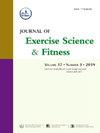Influence of local and remote ischemic preconditioning on 3-min all-out exercise performance: A randomized controlled crossover study
IF 2.4
2区 医学
Q2 SPORT SCIENCES
引用次数: 0
Abstract
Objective
This study investigated the influences of local ischemic preconditioning (LIPC) and remote ischemic preconditioning (RIPC) on muscle deoxygenation before and during a 3-min all-out cycling test (3 MT), as well as on 3 MT performance.
Methods
Fifteen male athletes completed LIPC (thighs, 220 mmHg, 4 × 5 min), RIPC (upper limbs, 30 mmHg above systolic blood pressure, 4 × 5 min), and SHAM (thighs, 20 mmHg, 4 × 5 min) interventions in a randomized crossover design, with a 4-day washout period between sessions. The 3 MT was conducted 45 min after each intervention. Parameters derived from the 3 MT included end-test power output (EP) and the work performed above EP (WEP). Muscle oxygenation of the thigh and blood biochemical variables (lactate, pH, nitric oxide, and norepinephrine) were assessed before and during exercise.
Results
During the resting period between the intervention and the 3 MT, deoxyhemoglobin and total hemoglobin were significantly higher in the LIPC condition than in RIPC and SHAM (P < 0.05). However, no significant differences were observed among conditions in peak oxygen uptake, slow component amplitude, EP, WEP, or blood biochemical variables during the 3 MT.
Conclusion
LIPC increased muscle total hemoglobin during the post-intervention resting period, particularly within 10 min of the final occlusion. However, neither LIPC nor RIPC improved performance during high-intensity cycling exercise.
局部和远程缺血预处理对3分钟全力运动表现的影响:一项随机对照交叉研究
目的探讨局部缺血预处理(LIPC)和远端缺血预处理(RIPC)对3 min全力循环试验(3mt)前、中肌肉脱氧的影响,以及对3mt运动成绩的影响。方法15名男性运动员在随机交叉设计中完成LIPC(大腿,220毫米汞柱,4 × 5分钟)、RIPC(上肢,收收压高于30毫米汞柱,4 × 5分钟)和SHAM(大腿,20毫米汞柱,4 × 5分钟)干预,两次干预之间有4天的洗脱期。3 MT在每次干预后45分钟进行。从3 MT得出的参数包括最终测试功率输出(EP)和在EP以上执行的工作(WEP)。在运动前和运动中评估大腿肌肉氧合和血液生化变量(乳酸、pH、一氧化氮和去甲肾上腺素)。结果在干预至3 MT的静息期,LIPC组的脱氧血红蛋白和总血红蛋白明显高于RIPC组和SHAM组(P <;0.05)。然而,在3个小时内,不同条件下的峰值摄氧量、慢组分振幅、EP、WEP或血液生化指标均无显著差异。结论lipc在干预后静息期增加了肌肉总血红蛋白,特别是在最终闭塞后10分钟内。然而,在高强度的自行车运动中,LIPC和RIPC都没有改善性能。
本文章由计算机程序翻译,如有差异,请以英文原文为准。
求助全文
约1分钟内获得全文
求助全文
来源期刊
CiteScore
5.10
自引率
3.60%
发文量
54
审稿时长
31 days
期刊介绍:
The Journal of Exercise Science and Fitness is the official peer-reviewed journal of The Society of Chinese Scholars on Exercise Physiology and Fitness (SCSEPF), the Physical Fitness Association of Hong Kong, China (HKPFA), and the Hong Kong Association of Sports Medicine and Sports Science (HKASMSS). It is published twice a year, in June and December, by Elsevier.
The Journal accepts original investigations, comprehensive reviews, case studies and short communications on current topics in exercise science, physical fitness and physical education.

 求助内容:
求助内容: 应助结果提醒方式:
应助结果提醒方式:


